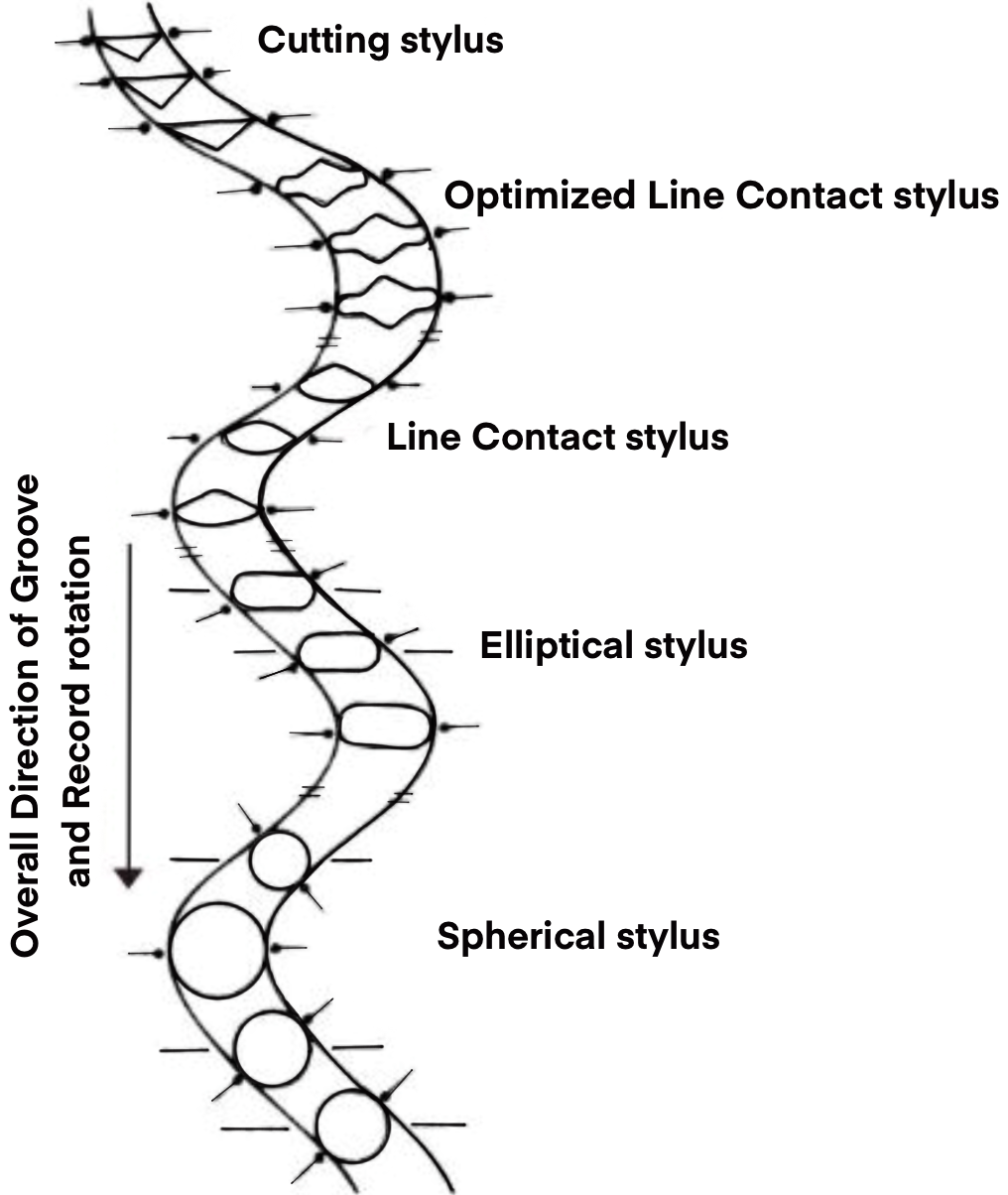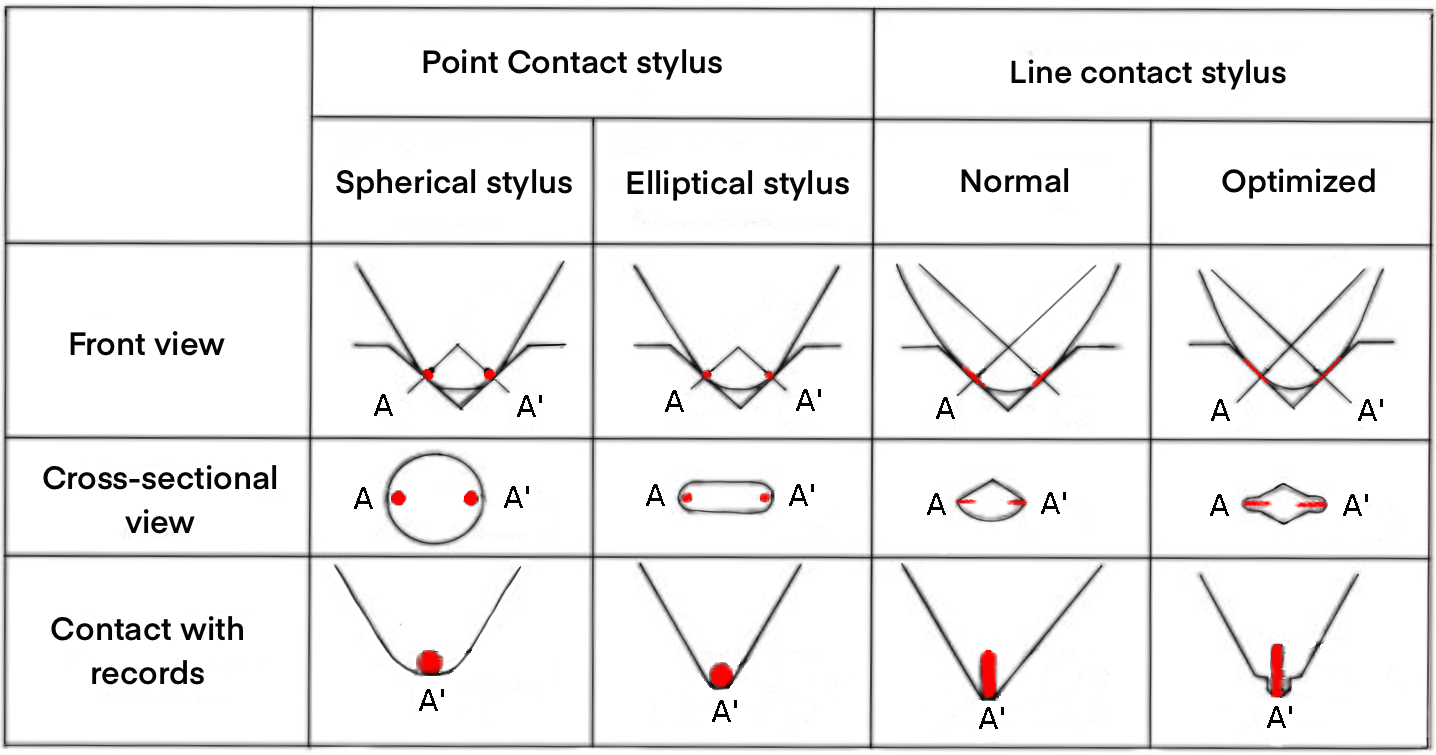Introduction to Phonograph Stylus Profiles
Posted On: May 7, 2020
Categories: Insights
As most record enthusiasts will agree the playback of vinyl records is a bit of a technical discipline where one can spend lots of time pondering minute technical details.
One of the questions that confronts you as soon as you consider a new cartridge or replacement stylus is that of stylus profile. When we talk about the stylus profile we mean the exact shape of the tiny diamond tip that touches the record groove during vinyl playback. This shape is important because good contact between groove and tip is instrumental for good tracking - and good tracking makes good sound (and less record wear).
Before we go on to consider the properties of various stylus shapes, let us first discuss how the groove is created in the first place: The process is performed by a cutting lathe, a machine that drags a sharp v-shaped cutting stylus in a linear fashion through the surface of a disc while undulating left, right, up, and down in accordance with the musical wave patterns. The stereo signal is thus encoded into an essentially v-shaped groove that undulates in two dimensions as you trace it. During this process the cutting head is always perpendicular to the overall direction of the groove.
During playback the goal of the phono cartridge is to decode the undulations of the groove back into the stereo signal originally encoded by the cutting stylus. Because of the perpendicular alignment of the cutter head nearly 100% perfect time alignment in the decoding process is only possible if the used stylus is able to trace the groove in a similar perpendicular manner. This explains why the stylus profiles discussed in the following are of different (an increasing) objective quality.
The Spherical Stylus
The simplest and oldest stylus shape is the Spherical, or Conical, stylus. This profile is very cost effective and therefore almost invariably the basis of very cheap cartridges and needles. It is shaped more or less like a ball-point pen and has a nice rounded tip.
Of all used profiles the spherical is furthest from the sharp v-shape of the cutting head. It is therefore inherently the poorest for time aligned groove decoding. In principle, you can reduce the decoding error by shrinking the tip diameter. If the tip becomes too pointy, however, it will ride too low in the groove and damage your records. In practice the diameter is always around 0.6 mil.
Due to the round shape the stylus will only ever touch the groove in two discrete spots. This leads to a very small contact area and therefore a high pressure on the touched record surfaces. While higher pressure leads to higher wear it is important to note that wear induced to a spherical stylus is very localized. Basically, the record groove will only be worn along the exact path of the stylus contact, which depends on the diameter of the tip. Records worn in this way will often sound pristine if a better stylus is user at a later time, simply because the new stylus rides the grove differently.

The Elliptical Stylus
The Elliptical stylus profile attempts to overcome the time alignment issues of the Spherical profile while avoiding the problems associated with very low diameter. The basic idea is to reduce the diameter of the Spherical tip in one dimension only. The resulting Elliptical tip is aligned in the groove such that the long axis is perpendicular to the overall direction of the groove. The result is a tip that is much closer in shape to the cutting head but still does not ride deep enough in the groove to ruin the record. In principle, Elliptical styli can also be improved by reducing the diameter. Like the Spherical profile, however, reductions on the long (side-to-side) axis can cause the stylus to ride too low in the groove and damage your records. But quality improvements by reductions on the short (front-to-back) axis are very real, and the length of this axis ranges from 0.4 mil (lowest quality) to 0.2 mil (highest quality).
Since the tip is still rounded some inherent issues of the spherical stylus remain and are even accentuated. Thus, the Elliptical stylus still only touches the record groove in two discrete points at any time. And because of the reduced diameter on one axis the total area of contact is smaller than for the Spherical stylus. Thus, the pressure on the touched surfaces are even greater than for Spherical styli, and we should also expect increased wear. Luckily the wear patterns will be similar in nature and can later be overcome by the use of a better stylus.

The Line Contact Stylus
The category of Line Contact Styli ranges over various sub-types that all refine the Elliptical profile in order to improve tracking and reduce wear. On the one hand, these refined shapes have a short front-to-back axis that rivals or surpasses the Elliptical profile in this respect. On the other hand, they reduce the curvature of the resulting sharp side edges in order to allow longer lines of edge to touch the groove walls at the same time. The sharper side gives more precise tracking and time alignment. The longer line of contact reduces the pressure per area of contact thereby reducing wear.
The first profile to achieve this was the Shibata in the late '60s, and a number of competing profiles have since appeared under names like Hyper Elliptical, Stereohedron, Line Contact, Fine Line etc. These profiles all strive to achieve the same things - a sharp side edge with an extended line of contact - and are therefore somewhat similar. Note that the terms Hyper Elliptical and Line Contact are general and may range of a variety of dimensions. Shibata, Stereohedron, and Fine Line, however, are patented definite shapes.
The Line Contact profiles are all objectively better than Spherical and Elliptical styli but also more difficult to use. Since the edges are sharper and the tips more v-shaped with less rounding record damage may occur if the stylus' side-to-side axis is not nearly perpendicular to the overall direction of the grove in the horizontal plane (zenith) or the stylus is not nearly perpendicular to the groove when seen from the front (azimuth). If carefully set up, however, these profiles will reward you with less record wear and very precise tracking. And remember, good tracking is good sound.
Optimized Stylus Profiles
By now we have solved almost all stylus related issues and Line Contact styli are generally very very good. One general problem remains, however: All styli are worn during record playback and wear degrades their performance. Would it not be nice to solve this one last problem (and possibly even improve performance)?
This thought has given us a number of optimized profiles, like the Micro Line, Micro Ridge, VanDenHull, FritzGeiger, SAS, and Paratrace. They all feature a cut-away just below the very tip that is sort of ridge shaped. Imagine a Line Contact profile with an extra v-shaped protrusion placed like a hat on the tip.
These profiles achieve an even sharper (Micro) edge to trace the groove walls and also lower sensitivity to stylus wear. Basically, the performance will remain more or less constant until the v-shaped protrusion is completely worn down, after which the performance will degrade very rapidly. When such amounts of wear accumulate record wear will also accelerate, and one must therefore pay close attention to the condition of these kinds of styli.
Stylus Profile Durability
The well known stylus manufacturer Jico reports the following playing times before audible degradation at 15kHz is as follows:
- Spherical / Conical
- 150 hours
- Elliptical
- 250 hours
- Line contact
- 400 hours
- Optimized
- 500 hours
These are the times after which styli will start degrade in performance. The optimized profiles may go quickly downhill after this, but the other types are likely to endure at least twice the stated time before any excessive record wear occurs.
Buyer advice
Every vinyl listener is different. Some listen much and some listen less frequently. Some want to resurrect an old turntable or cartridge and others want a nice new player or cartridge. Some are passionate audiophiles and others are less so. So of course, there is no stylus profile that is best for everyone.
If you are not a passionate audiophile and only play your records occasionally, then a Spherical stylus could be just the right tool for you. if you are looking for a cartridge, then one of our entry level Goldring E-line cartridges may fit the bill. If you are looking for a stylus replacement, then we have plenty of cost-efficient alternatives to choose from.
If you care about sound quality but only play your records once in while, then an Elliptical cartridge easily betters the Spherical alternatives without breaking the bank. You may even want to consider a simple Line Contact profile. If you already have a cartridge, we can most likely help you with an elliptical replacement needle or maybe even a simple Line Contact replacement.
If you play your records non-stop, then Line Contact cartridges will be the preference of your record collection. They will wear your records less, endure longer, and sound better at the same time. For replacement needles the same argument applies. Also, a Line Contact stylus is a good supplement to simpler Point Contact styli because they read the groove differently.
Finally, if you need the best of the best or you just want to look after your record collection in the best way possible, then you are probably ready for a cartridge with Fine Line, or maybe Micro Ridge, stylus. Or maybe your existing cartridge is just ready for a Super Analogue Stylus.
If in doubt about the best fit for your need, then do not hesitate to contact us - we are happy to help.

